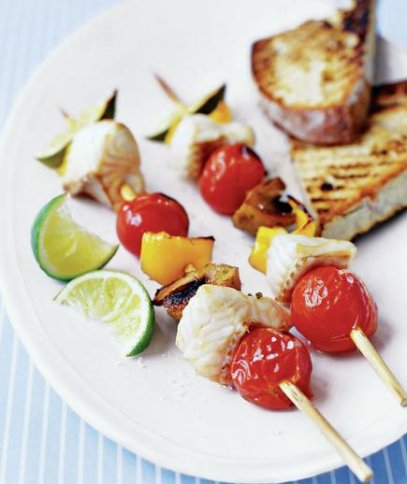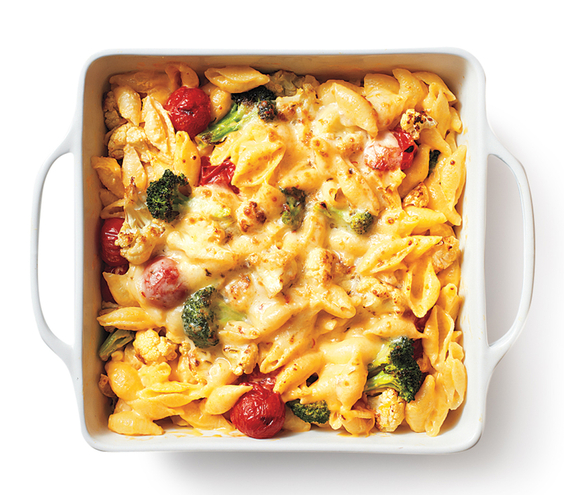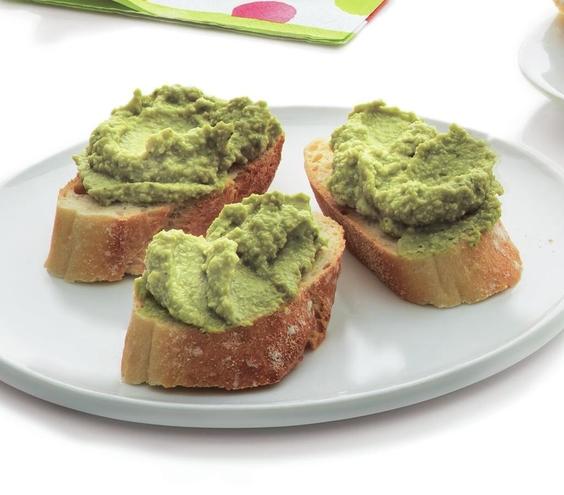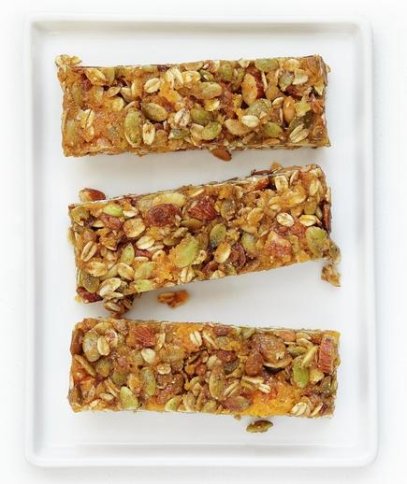Get picky kids excited about lunchtime with these creative tips and nutritious meal ideas
Go Beyond the Basics

While it might be tempting to stick to sandwiches, plain PB&Js can quickly lose their appeal. Instead, experiment with anything from whole-wheat mini bagels to protein-packed kebabs, which will get kids excited about trying new foods, says Janice Newell Bissex, M.S., R.D.N., co-founder of Meal Makeover Moms. Pasta salad keeps well and can be tailored to kids’ preferences, while baked whole-grain tortilla chips are fun for scooping up salmon or tuna.
Breakfast for lunch is always popular with kids, says Bissex, who suggests whipping up whole-grain pancakes on Sunday and packing leftovers throughout the week. For an added punch of protein, layer peanut butter between two pancakes. Vary the pancake flavors by trying pumpkin, banana-blueberry, or gingerbread.
Play With Presentation
[time-brightcove not-tgx=”true”]
A few simple tweaks in prepping and packaging can encourage choosy kids to give new foods a try. Because lunchtime is social and kids are often distracted, the easier the foods are to eat, the better, says Bissex. Bite-sized foods work well packed into Bento-style lunchboxes, and fun, frilly toothpicks can be packed with small cubes of fruit and cheese. Protein, fruits, and veggies look great on a skewer, anddippable meals are always a hit.
You can have fun with sandwiches, too, says Catherine McCord, founder of Weelicious. She suggests cutting them into “sushi,” by rolling, slicing, and portioning sandwiches into individual bites. Packing brightly-colored produce, such as raspberries and cherry tomatoes, adds a visual pop of color to a lunchbox as well, she says.
Lighten Up Their Favorites

Whether you sneak in some veggies or swap in whole grains, you can bulk up nutrition without sacrificing flavor. “It’s about starting with what they like and tweaking it just a little bit,” Bissex says. “When we eat macaroni and cheese, we make our own cheese sauce and we add a little bit of carrot. Our coconut chicken fingers use whole grain in the breading, a good oil [for sauteeing], and a little coconut for interest.”
Once you’ve mastered the new recipe, send leftovers for lunch. “I always say, whatever you can use from dinner last night, try to, because it makes preparing meals so much easier,” McCord says.
Take Time With New Foods

If your child refuses to eat certain foods, it can be hard to know when to keep trying and when give up. Studies have shown kids can come around after repeated tastings—but it’s not a fool-proof solution, Bissex says. “I think it’s true for many kids with many foods, but it’s not true for all kids with all foods,” she says.
Tanya Steel, CEO of Cooking Up Big Dreams and author of Real Food for Healthy Kids, suggests putting a small amount of a new food in a lunchbox, and continuing to reintroduce it on and off for several weeks. “If at the end they still don’t like it, switch it up to something in the same food family,” she says. “For instance, if they don’t like kale after a bunch of tries, give them rainbow chard or spinach ‘chips’ (drizzle spinach with olive oil and bake until crisp), or even sugar snaps or edamame.”
Make the Snacks at Home

Making homemade versions of the kids’ favorite snacks is a nutritious way to satisfy their taste buds. Granola bars packed with apricots, oats, and almonds have much less sugar and fewer additives than store-bought, but are just as tasty and will fuel them for school. “You want to make sure that you’re sending something that they’re going to be getting energy from, or that can really tide them over ’til dinner,” McCord says.
If you go the store-bought route, stick to fruits, nuts, and items with small ingredient lists. “All around great [options] include baked pita chips, almonds and walnuts, low-sugar granola, yogurts with low sugar content, grapes, bananas, and the like,” Steel says. “Dark chocolate is a great daily treat.”
This article originally appeared on Real Simple
More from Real Simple:
- 3 Recipes So Simple the Kids Can Make Dinner
- 3 Recipes for Busy Families
- 4 Easy, Tasty Cookie Recipes
-
Go Beyond the Basics

Antonis Achilleos While it might be tempting to stick to sandwiches, plain PB&Js can quickly lose their appeal. Instead, experiment with anything from whole-wheat mini bagels to protein-packed kebabs, which will get kids excited about trying new foods, says Janice Newell Bissex, M.S., R.D.N., co-founder of Meal Makeover Moms. Pasta salad keeps well and can be tailored to kids’ preferences, while baked whole-grain tortilla chips are fun for scooping up salmon or tuna.
Breakfast for lunch is always popular with kids, says Bissex, who suggests whipping up whole-grain pancakes on Sunday and packing leftovers throughout the week. For an added punch of protein, layer peanut butter between two pancakes. Vary the pancake flavors by trying pumpkin, banana-blueberry, or gingerbread.
-
Play With Presentation

Tina Rupp A few simple tweaks in prepping and packaging can encourage choosy kids to give new foods a try. Because lunchtime is social and kids are often distracted, the easier the foods are to eat, the better, says Bissex. Bite-sized foods work well packed into Bento-style lunchboxes, and fun, frilly toothpicks can be packed with small cubes of fruit and cheese. Protein, fruits, and veggies look great on a skewer, anddippable meals are always a hit.
You can have fun with sandwiches, too, says Catherine McCord, founder of Weelicious. She suggests cutting them into “sushi,” by rolling, slicing, and portioning sandwiches into individual bites. Packing brightly-colored produce, such as raspberries and cherry tomatoes, adds a visual pop of color to a lunchbox as well, she says.
-
Lighten Up Their Favorites

Christopher Testani Whether you sneak in some veggies or swap in whole grains, you can bulk up nutrition without sacrificing flavor. “It’s about starting with what they like and tweaking it just a little bit,” Bissex says. “When we eat macaroni and cheese, we make our own cheese sauce and we add a little bit of carrot. Our coconut chicken fingers use whole grain in the breading, a good oil [for sauteeing], and a little coconut for interest.”
Once you’ve mastered the new recipe, send leftovers for lunch. “I always say, whatever you can use from dinner last night, try to, because it makes preparing meals so much easier,” McCord says.
-
Take Time With New Foods

Levi Brown If your child refuses to eat certain foods, it can be hard to know when to keep trying and when give up. Studies have shown kids can come around after repeated tastings—but it’s not a fool-proof solution, Bissex says. “I think it’s true for many kids with many foods, but it’s not true for all kids with all foods,” she says.
Tanya Steel, CEO of Cooking Up Big Dreams and author of Real Food for Healthy Kids, suggests putting a small amount of a new food in a lunchbox, and continuing to reintroduce it on and off for several weeks. “If at the end they still don’t like it, switch it up to something in the same food family,” she says. “For instance, if they don’t like kale after a bunch of tries, give them rainbow chard or spinach ‘chips’ (drizzle spinach with olive oil and bake until crisp), or even sugar snaps or edamame.”
-
Make the Snacks at Home

Philip Friedman and Colleen Riley Making homemade versions of the kids’ favorite snacks is a nutritious way to satisfy their taste buds. Granola bars packed with apricots, oats, and almonds have much less sugar and fewer additives than store-bought, but are just as tasty and will fuel them for school. “You want to make sure that you’re sending something that they’re going to be getting energy from, or that can really tide them over ’til dinner,” McCord says.
If you go the store-bought route, stick to fruits, nuts, and items with small ingredient lists. “All around great [options] include baked pita chips, almonds and walnuts, low-sugar granola, yogurts with low sugar content, grapes, bananas, and the like,” Steel says. “Dark chocolate is a great daily treat.”
This article originally appeared on Real Simple
More from Real Simple: